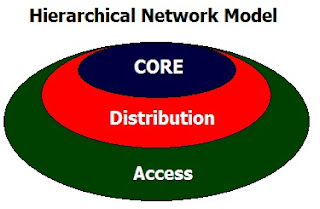Hierarchical Network Model - Network Design
To build a LAN, it is necessary to take into account many aspects to the network meets the needs of small and medium enterprises, ie designing the network is necessary to use techniques to get closer to success.
The hierarchical model has many benefits, as it allows the network more predictable. This, because the campus network is divided into layers and each layer defined in the services they provide. Compared to other network designs, a hierarchical network is managed and expanded more easily and resolve problems faster.

Among the advantages that exist to separate the networks in three levels, is that it is easier to design, implement, maintain and scale the network, plus it makes it more reliable, with better cost / benefit ratio. Each layer has specific functions assigned and not necessarily refer to a physical separation, but logic, so that various devices can have a single layer or a device by the features of more than one of the layers.
The layers and their typical functions are:
In the access layer equipment can be found the following characteristics:
In the distribution layer, it is advisable to purchase equipment which complies with the following features.
While in the core layer, the switches have the following characteristics:
The hierarchical model has many benefits, as it allows the network more predictable. This, because the campus network is divided into layers and each layer defined in the services they provide. Compared to other network designs, a hierarchical network is managed and expanded more easily and resolve problems faster.

Among the advantages that exist to separate the networks in three levels, is that it is easier to design, implement, maintain and scale the network, plus it makes it more reliable, with better cost / benefit ratio. Each layer has specific functions assigned and not necessarily refer to a physical separation, but logic, so that various devices can have a single layer or a device by the features of more than one of the layers.
The layers and their typical functions are:
- The access layer, and controls the users access workgroup (workgroup access) or network resources. This layer performs the Ethernet switching. The access layer interfaces with end devices such as PCs, printers and IP phones, to provide access to the rest of the network. The access layer can include routers, switches, bridges, hubs, and wireless access points (AP). The main purpose of the access layer is to provide a means of connection to the network devices and control devices which can communicate over the network.
- The distribution layer is the means of communication between the access layer and the core. The functions of this layer are to provide routing, packet filtering, access to the WAN and determine which packets must arrive at Core. It also determines what is the fastest way to meet network requirements, for example, how to bring a file from a server.
Here also are deployed network policies, eg routing, access-list, packet filtering, queuing, security is implemented and network policies, routing between VLANs and other workgroup functions are defined domains broadcast and multicast.
- The core layer is literally the core of the network, its only function is to switch traffic as fast as possible and is responsible for carrying large amounts of traffic in a reliable and fast, so the latency and speed are important factors in this layer.
In case of failure, it affects all users, so that fault tolerance is important. Moreover, given the importance of speed, does not function as may increase latency, and access-list, interVLAN routing, packet filtering.
The core layer is essential for interconnectivity among devices of the distribution layer, therefore, it is important that the core is highly available and redundant.
The selection of switches or network equipment should be considered according to the requirements of each layer based on the hierarchical model.
In the access layer equipment can be found the following characteristics:
- 10/100/1000 Ethernet connectivity.
- PoE
- vlan
- QoS
In the distribution layer, it is advisable to purchase equipment which complies with the following features.
- Redundant links.
- Connections to 1G or 10G
- Capacity Routing (L2 and L3 Switches)
- QoS
- High switching capacity, like forwarding high rates.
While in the core layer, the switches have the following characteristics:
- Connections to 1G or 10G
- QoS
- High switching capacity, like forwarding high rates.
- Redundant links.
0 Comments:
Post a Comment